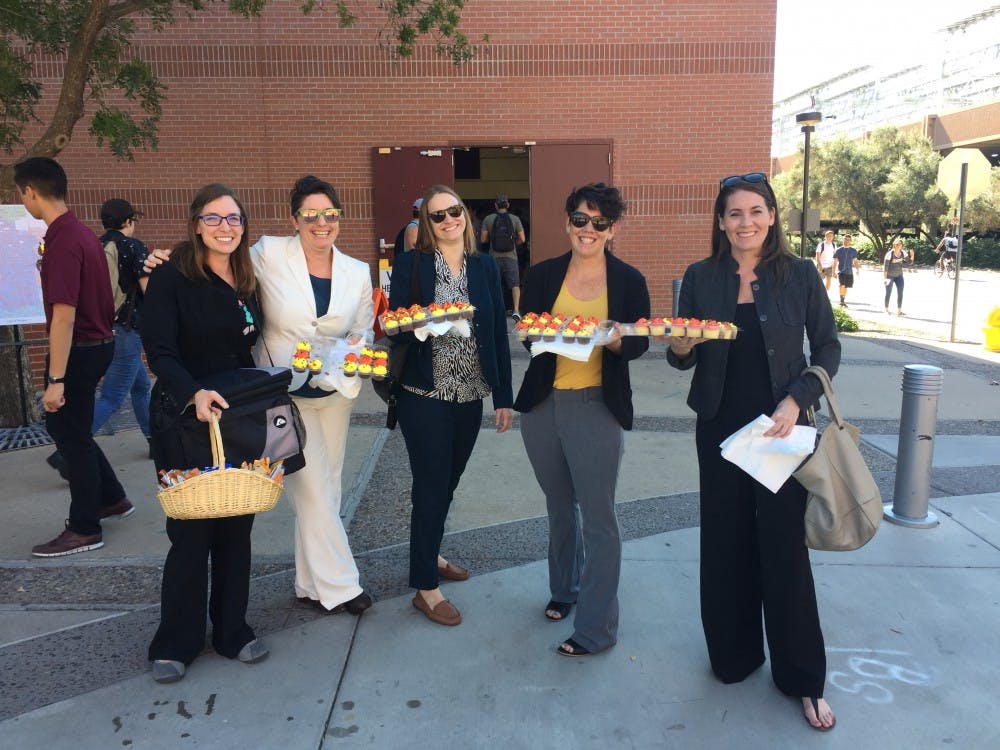As both major presidential candidates took the stage at political rallies throughout their respective campaigns — even through election week — both camps shared a similar narrative: Who will win the Latino vote?
This election, Latino voters recorded higher early-voter turnouts in Arizona. On Oct. 30, 13 percent of all early ballots cast in Arizona came from Latino voters. In the 2012 presidential election, the percentage of Latino voters who cast early ballots was 11 percent and eight percent in 2008, according to The Arizona Republic.
However, regardless of the large amount of early voting Latinos, less than half of those who were registered to vote did not vote on Election Day. Nationally, there were approximately 27 million registered Latinos — roughly 13 million of them voted, according to the Morrison Institute for Public Policy, a research institute focused on examining critical issues and providing a catalyst for public dialogue.
Joseph Garcia, the director of the Latino Public Policy Center at the Morrison Institute, said the reason there were so many Latino early voters is that Election Day isn’t convenient for the Latino demographic, forcing them to cast their vote earlier.
“The way the elections are set up on Tuesdays aren’t really conducive to Latinos — especially workers,” Garcia said. “Let’s say you’re a roofer, and your job is 35 miles out of town, and you have to get up early before the polls open, you’re on the job site, you finish it — by the time you come home, it's after seven — you missed your chance to vote.”
Although the Hispanic vote did not turn out as well as many assumed, Garcia said Arizona’s Latino vote is still on the rise and is only going to get larger for future elections.
“Arizona’s Latino population is still a young population with the median age of Latinos in Arizona being age 25,” Garcia said. “That means a lot of Latinos are not yet eligible to vote. About a third of the adult population of Latinos now cannot vote, because they’re not U.S. citizens. All the youngsters who are not 18 will be able to vote because they were born here and have U.S. citizenship.”
According to America’s Emerging Latino Vote, a report done by the Morrison Institute, by 2030, it is projected that 35 percent of Arizona’s population will be Latino. This would constitute a 178 percent increase in the number of Latino citizens aged 20 and older from 2010 to 2030.
Although the voter turnout among Latinos was underwhelming on a national scale, James Garcia, the director of communications and public policy at the Arizona Hispanic Chamber of Commerce, said Latino voters had a tremendous impact on the 2016 presidential election in Arizona.
“It’s certainly documented already that we had a historic number of Hispanic voters registered in the state — about 709,000 — which is a substantial growth from four years ago,” James Garcia said. “I haven’t seen the specific numbers in terms of final turnout on Election Day, but I believe that is also going to be around the 70 percent-plus range, which historically for the Hispanic community will also be very impressive.”
James Garcia also said it’s not just Latinos who didn’t show up to the polls on Election Day.
“Latino voters in this election did their job," he said. "They turned out in historic numbers, they registered in historic numbers and they voted distinctly against a candidate whom they concluded was anathema to them. To somehow suggest that Latino voters didn’t do their job is simply ignoring the facts because nearly half of all American voters did not vote.”
Many suggest that the seemingly unflattering rhetoric Trump used in describing Latinos would lead to an increased Latino vote, which they predicted would catapult Clinton into the White House.
However, some Latino advocates, such as Eduardo Samaniego, a constitutional law and education policy junior at Hampshire College, think the Clinton campaign did not do as much as it could have to bring out more of the Latino vote.
"The Latino community has been a very neglected community by the Democratic party," Samaniego said. "They haven't invested an infrastructure in turnout or civic engagement, as they have invested in other communities. This time around, (Latinos) came out to vote in historic numbers, because of the fear of Donald Trump — not because of the Democratic investment in our community,"
Samaniego said community outreach and education directed toward Latino voters can show the true power this demographic holds.
"I do believe there is so much the Democratic party can do — educating people and making sure there are organizations engaging people on a local level," Samaniego said. "Until then, we cannot really show our real strength. This is not only a reminder of how much the Latino vote will continue to grow, but also how much more attention both Democrats and Republicans need to put to the Latino vote."
Reach the reporter at vkeys@asu.edu or follow @VKeys1231 on Twitter.
Like The State Press on Facebook and follow @statepress on Twitter.





